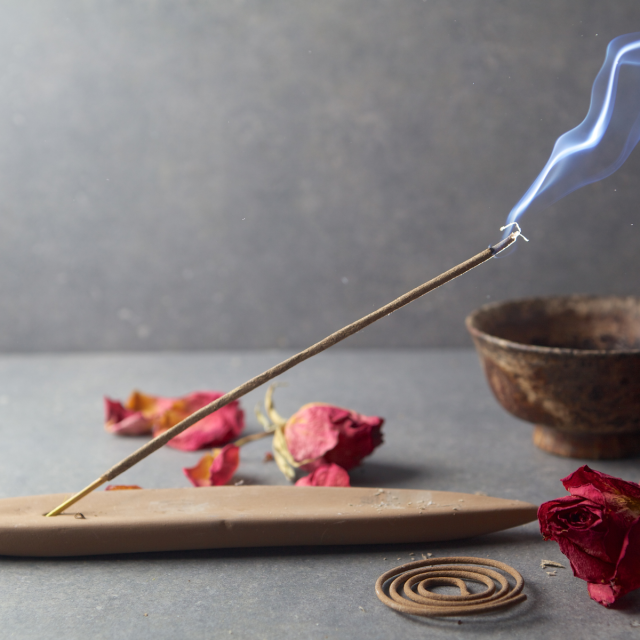Incense sticks, with their aromatic smoke and cultural significance, have been used for centuries to enhance meditation, create a calming atmosphere, and mask unpleasant odors. But for the uninitiated, the burning process can seem shrouded in mystery. Fear not, fragrance enthusiasts! This comprehensive guide empowers you to confidently use incense sticks, transforming your space into an olfactory oasis.
Understanding Incense: Exploring Different Types and Use incense sticks
The world of incense offers a diverse range of scents and styles to suit your preferences. Here’s a glimpse into some popular types:
- Masala Incense: Hailing from India, masala incense is a blend of aromatic ingredients like resins, essential oils, and sometimes even sandalwood. Masala sticks offer a complex and often sweet fragrance that can be calming and mood-lifting.
- Resin Incense: Frankincense and copal are popular examples of resin incense. These pure resin sticks offer a woody, balsamic aroma that is often used in religious ceremonies and meditation practices for its grounding and spiritual properties.
- Agarbatti Incense: Commonly found in India, agarbatti incense sticks are typically made from rolled bamboo coated with a paste of charcoal, essential oils, and fragrance powders. They come in a wide variety of scents, offering a more affordable option for those new to incense.
- Tibetan Incense: Tibetan incense sticks often incorporate medicinal herbs alongside fragrant resins and essential oils. They are traditionally used in Buddhist practices and are believed to promote healing and purification.
Beyond these types, explore other regional variations like Japanese incense or explore specific scents like sandalwood, lavender, or citrus to find your favorites.
Preparing the Stage: Choosing the Right Incense Burner and Accessories
The right incense burner not only complements your décor but also plays a crucial role in a safe and enjoyable incense experience. Here are some key considerations:
- Burner Material: Ceramic, metal, and stone are popular choices for incense burners. Ceramic burners offer a classic and heat-resistant option. Metal burners can be lightweight and portable, while stone burners add a natural element to your space.
- Burner Style: There are various burner styles to choose from. Ash catchers collect ashes for easy disposal and help maintain a clean burning experience. Cascade burners allow the incense smoke to flow down in a mesmerizing cascade. Travel burners offer a portable option for enjoying incense on the go.
- Additional Accessories: Long matches or a specifically designed incense lighter can help you safely ignite the incense stick. Tweezers can be helpful for handling hot or delicate incense. A dedicated ash tray can provide a safe and convenient place to dispose of ashes.
By selecting the right burner and accessories, you can create a safe and aesthetically pleasing environment for your incense burning ritual.
The Art of Burning: Lighting, Placement, and Safety Tips
Now comes the exciting part – experiencing the magic of burning incense! Here are some key steps to ensure a safe and enjoyable experience:
- Lighting the Incense: Hold the incense stick upright and light the very tip using a match or lighter. Let the flame burn for a few seconds, then gently blow it out. The tip of the incense should ember and emit a thin wisp of smoke.
- Placement: Place the incense stick securely in the designated holder of your burner. Ensure the incense is not placed near flammable materials like curtains or papers. Keep it out of reach of children and pets.
- Ventilation: While incense can mask unpleasant odors, proper ventilation is still crucial. Open a window slightly to allow some airflow and prevent smoke build-up, especially in smaller spaces.
- Mindfulness and Enjoyment: Relax, take a deep breath, and allow the calming aroma of the incense to fill the space. Incense burning can be a meditative practice in itself. Focus on the present moment and enjoy the fragrant experience.
Remember, patience is key. Sometimes it might take a few tries to get the incense to ember properly. Don’t force it – if the flame doesn’t go out after a few seconds, extinguish it and try relighting the tip.
Cultivating Calm: Exploring Different Incense Burning Techniques
Beyond the basic burning method, there are various techniques to explore for a more personalized incense experience:
- Indirect Burning: Instead of placing the incense directly in the burner’s holder, you can create a bed of sand or salt in the burner. Then, gently press the lit incense stick into the sand or salt. This indirect burning method can help regulate the burning temperature and potentially extend the life of the incense stick.
- Fragrance Layering: For a more complex olfactory experience, experiment with layering different incense scents. Start by burning one stick at a time, then introduce another scent after the first has burned for a while. Be mindful of the scents you choose – some might clash, while others can create beautiful aromatic harmonies.
- Clearing and Cleansing: Burning incense is often used for space clearing and purification rituals. Move slowly through your space with the burning incense stick, allowing the smoke to reach all corners. Visualize negative energy being drawn out and replaced by a sense of calm and positivity.
- Intention Setting: Imbue your incense burning ritual with intention. Light the incense with a specific purpose in mind, such as promoting relaxation, fostering creativity, or enhancing meditation. Focusing on your intention can deepen the experience and connect the fragrance to your desired outcome.
Remember, these techniques are just starting points. Feel free to experiment and discover what works best for you. Incense burning can be a personal and creative practice that allows you to tailor the experience to your specific needs and preferences.
Beyond the Burn: Proper Extinguishing and Ash Disposal
Once you’ve enjoyed the aromatic experience, it’s important to extinguish the incense properly and dispose of the ash safely. Here’s how:
- Extinguishing the Incense: Never extinguish a burning incense stick with water. Instead, gently press the glowing ember tip into the designated ash catcher of your burner or a bed of sand or salt. This will extinguish the ember safely and prevent smoldering.
- Ash Disposal: Allow the ashes to cool completely before disposing of them. Once cool, you can discard the ashes in a non-flammable container or ashtray. Avoid disposing of ashes directly in the trash, especially if they are still warm.
By following these simple steps, you can ensure a safe and responsible incense burning experience.
The Allure of Incense: A Journey for the Senses and Soul
Burning incense is more than just scenting a space; it’s a sensory experience that can enhance relaxation, elevate meditation practices, and create a calming atmosphere. With the knowledge you’ve gained from this guide, you can embark on your own fragrant journey, using incense to transform your space into a haven of peace and tranquility. Remember, the key is to experiment, find scents that resonate with you, and create a personalized ritual that brings a touch of serenity and fragrance into your life.
Bonus Section: Deepening Your Incense Experience
For those seeking to delve even further into the world of incense, here are some additional considerations:
- Understanding Fragrance Notes: Just like perfumes, incense can have a base note, a middle note, and a top note. The base note is the most long-lasting scent, while the top note is the first fragrance you perceive. Familiarizing yourself with fragrance notes can help you choose incense blends that create a desired olfactory experience.
- Exploring Different Cultures: Incense has a rich history and cultural significance across various regions. Researching the traditional uses of incense in different cultures can broaden your understanding and appreciation of this ancient practice. For example, Japanese incense ceremonies are known for their emphasis on mindfulness and simplicity, while some Indian traditions incorporate specific incense blends for various purposes like purification or meditation.
- Safe Storage: Store your incense sticks in a cool, dry place away from direct sunlight. Heat and humidity can degrade the quality of incense, affecting its aroma and burning properties. Airtight containers are ideal for preserving the fragrance and lifespan of your incense sticks.
- Sustainable Incense: If environmental consciousness is a priority, consider purchasing incense from companies committed to sustainable practices. Look for brands that use ethically sourced ingredients, minimize packaging waste, and support responsible harvesting methods.
- DIY Incense Blending: For the adventurous, explore the world of DIY incense blending. Experiment with combining different resins, herbs, and essential oils to create your own unique fragrance combinations. Research safety precautions and proper techniques before embarking on your incense-blending journey.

By incorporating these additional considerations, you can elevate your incense experience to a whole new level. From understanding the nuances of fragrance notes to delving into the cultural significance of incense, there’s always more to discover in this fascinating world. Remember, the journey of exploring incense is a personal one. Embrace the process, experiment with different scents and techniques, and allow incense to become a source of relaxation, creativity, and a connection to ancient traditions.







